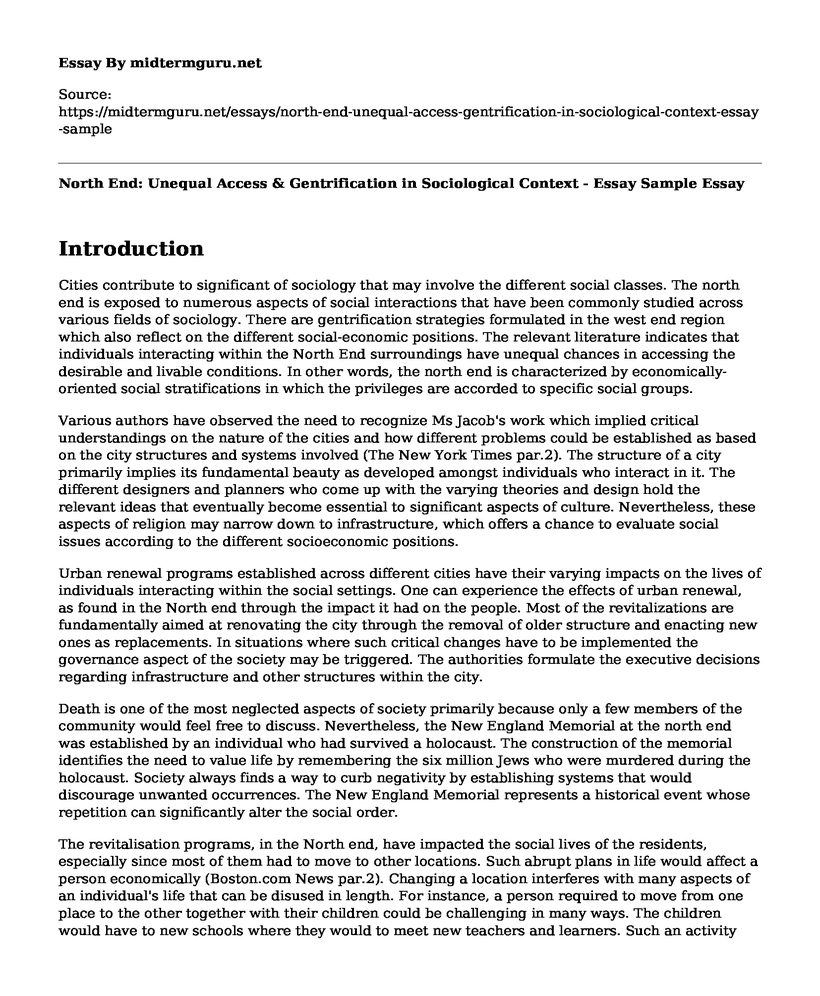Introduction
Cities contribute to significant of sociology that may involve the different social classes. The north end is exposed to numerous aspects of social interactions that have been commonly studied across various fields of sociology. There are gentrification strategies formulated in the west end region which also reflect on the different social-economic positions. The relevant literature indicates that individuals interacting within the North End surroundings have unequal chances in accessing the desirable and livable conditions. In other words, the north end is characterized by economically-oriented social stratifications in which the privileges are accorded to specific social groups.
Various authors have observed the need to recognize Ms Jacob's work which implied critical understandings on the nature of the cities and how different problems could be established as based on the city structures and systems involved (The New York Times par.2). The structure of a city primarily implies its fundamental beauty as developed amongst individuals who interact in it. The different designers and planners who come up with the varying theories and design hold the relevant ideas that eventually become essential to significant aspects of culture. Nevertheless, these aspects of religion may narrow down to infrastructure, which offers a chance to evaluate social issues according to the different socioeconomic positions.
Urban renewal programs established across different cities have their varying impacts on the lives of individuals interacting within the social settings. One can experience the effects of urban renewal, as found in the North end through the impact it had on the people. Most of the revitalizations are fundamentally aimed at renovating the city through the removal of older structure and enacting new ones as replacements. In situations where such critical changes have to be implemented the governance aspect of the society may be triggered. The authorities formulate the executive decisions regarding infrastructure and other structures within the city.
Death is one of the most neglected aspects of society primarily because only a few members of the community would feel free to discuss. Nevertheless, the New England Memorial at the north end was established by an individual who had survived a holocaust. The construction of the memorial identifies the need to value life by remembering the six million Jews who were murdered during the holocaust. Society always finds a way to curb negativity by establishing systems that would discourage unwanted occurrences. The New England Memorial represents a historical event whose repetition can significantly alter the social order.
The revitalisation programs, in the North end, have impacted the social lives of the residents, especially since most of them had to move to other locations. Such abrupt plans in life would affect a person economically (Boston.com News par.2). Changing a location interferes with many aspects of an individual's life that can be disused in length. For instance, a person required to move from one place to the other together with their children could be challenging in many ways. The children would have to new schools where they would to meet new teachers and learners. Such an activity would imply financial costs that would be difficult to handle depending on the socio-economic class of the affected individuals - all these aspects of culture impact in accordance to the different situations that a city face. Despite the pressing needs to beautify and enhance the state of a given city, the costs might be socially detrimental. Some of the questions raised in such situations seek justification on whether some of these developmental projects are worth altering the social structures. Also, what is the role of the government in ensuring compensation and critical administration of changes?
Work Cited
Boston.com News. There goes the neighbourhood: As middle-class families with children leave Boston in droves, are we becoming what author Joel Kotkin calls an 'ephemeral city'? (the 14th day of May 2006). [Online]. Retrieved from: http://archive.boston.com/news/globe/ideas/articles/2006/05/14/there_goes_the_neighborhood/?page=full (Accessed on the 2nd day of October 2019).
The New York Times. Outgrowing Jane Jacobs and Her New York. (the 30th day of April 2006). [Online]. Retrieved from: https://www.nytimes.com/2006/04/30/weekinreview/outgrowing-jane-jacobs-and-her-new-york.html (Accessed on the 2nd day of October 2019).
Cite this page
North End: Unequal Access & Gentrification in Sociological Context - Essay Sample. (2023, Feb 21). Retrieved from https://midtermguru.com/essays/north-end-unequal-access-gentrification-in-sociological-context-essay-sample
If you are the original author of this essay and no longer wish to have it published on the midtermguru.com website, please click below to request its removal:
- Assignment Example on Policy Issues for Elderly LGBT Individuals
- Paper Example on Donor Behavior
- Essay Sample on Human Services and Community Partnerships
- Research Paper on Discrimination: Race and Color
- Essay Sample on Race, Sexuality, and Fantasy
- Alcoholism: Consequences, Addiction, and Rehabilitation - Essay Sample
- Influence of Gender Inequality on Domestic Violence in the Connection to the Susan Glaspell "A Jury of Her Peers"







